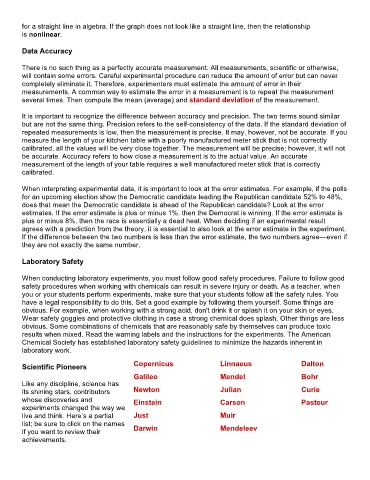Page 360 - ABCTE Study Guide_Neat
P. 360
for a straight line in algebra. If the graph does not look like a straight line, then the relationship
is nonlinear.
Data Accuracy
There is no such thing as a perfectly accurate measurement. All measurements, scientific or otherwise,
will contain some errors. Careful experimental procedure can reduce the amount of error but can never
completely eliminate it. Therefore, experimenters must estimate the amount of error in their
measurements. A common way to estimate the error in a measurement is to repeat the measurement
several times. Then compute the mean (average) and standard deviation of the measurement.
It is important to recognize the difference between accuracy and precision. The two terms sound similar
but are not the same thing. Precision refers to the self-consistency of the data. If the standard deviation of
repeated measurements is low, then the measurement is precise. It may, however, not be accurate. If you
measure the length of your kitchen table with a poorly manufactured meter stick that is not correctly
calibrated, all the values will be very close together. The measurement will be precise; however, it will not
be accurate. Accuracy refers to how close a measurement is to the actual value. An accurate
measurement of the length of your table requires a well manufactured meter stick that is correctly
calibrated.
When interpreting experimental data, it is important to look at the error estimates. For example, if the polls
for an upcoming election show the Democratic candidate leading the Republican candidate 52% to 48%,
does that mean the Democratic candidate is ahead of the Republican candidate? Look at the error
estimates. If the error estimate is plus or minus 1%, then the Democrat is winning. If the error estimate is
plus or minus 8%, then the race is essentially a dead heat. When deciding if an experimental result
agrees with a prediction from the theory, it is essential to also look at the error estimate in the experiment.
If the difference between the two numbers is less than the error estimate, the two numbers agree—even if
they are not exactly the same number.
Laboratory Safety
When conducting laboratory experiments, you must follow good safety procedures. Failure to follow good
safety procedures when working with chemicals can result in severe injury or death. As a teacher, when
you or your students perform experiments, make sure that your students follow all the safety rules. You
have a legal responsibility to do this. Set a good example by following them yourself. Some things are
obvious. For example, when working with a strong acid, don't drink it or splash it on your skin or eyes.
Wear safety goggles and protective clothing in case a strong chemical does splash. Other things are less
obvious. Some combinations of chemicals that are reasonably safe by themselves can produce toxic
results when mixed. Read the warning labels and the instructions for the experiments. The American
Chemical Society has established laboratory safety guidelines to minimize the hazards inherent in
laboratory work.
Scientific Pioneers Copernicus Linnaeus Dalton
Galileo Mendel Bohr
Like any discipline, science has
its shining stars, contributors Newton Julian Curie
whose discoveries and Einstein Carson Pasteur
experiments changed the way we
live and think. Here’s a partial Just Muir
list; be sure to click on the names
if you want to review their Darwin Mendeleev
achievements.

